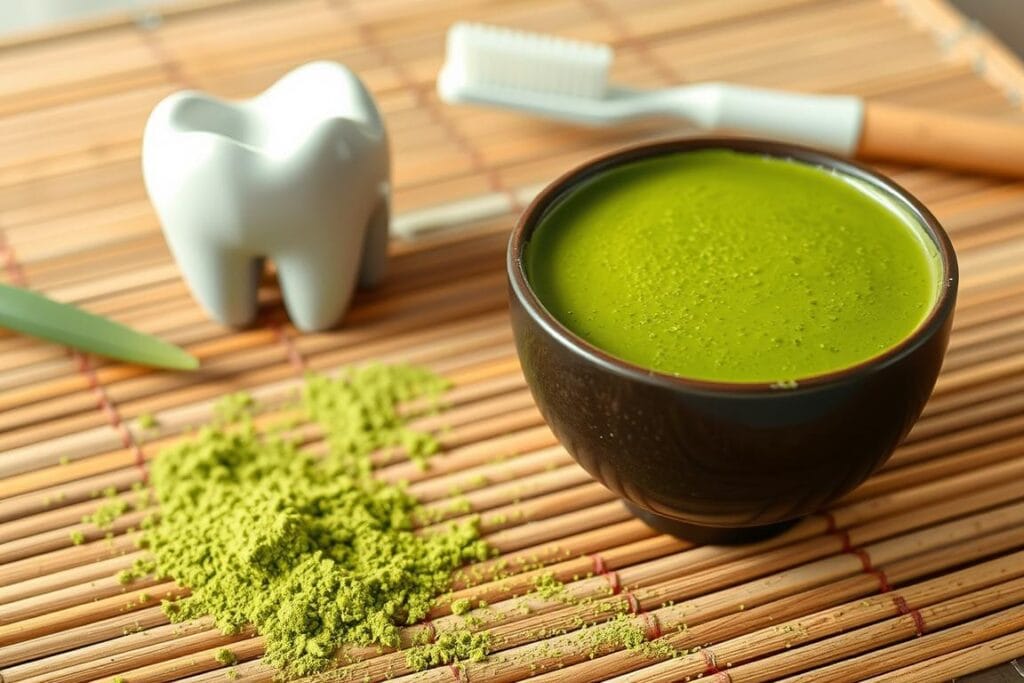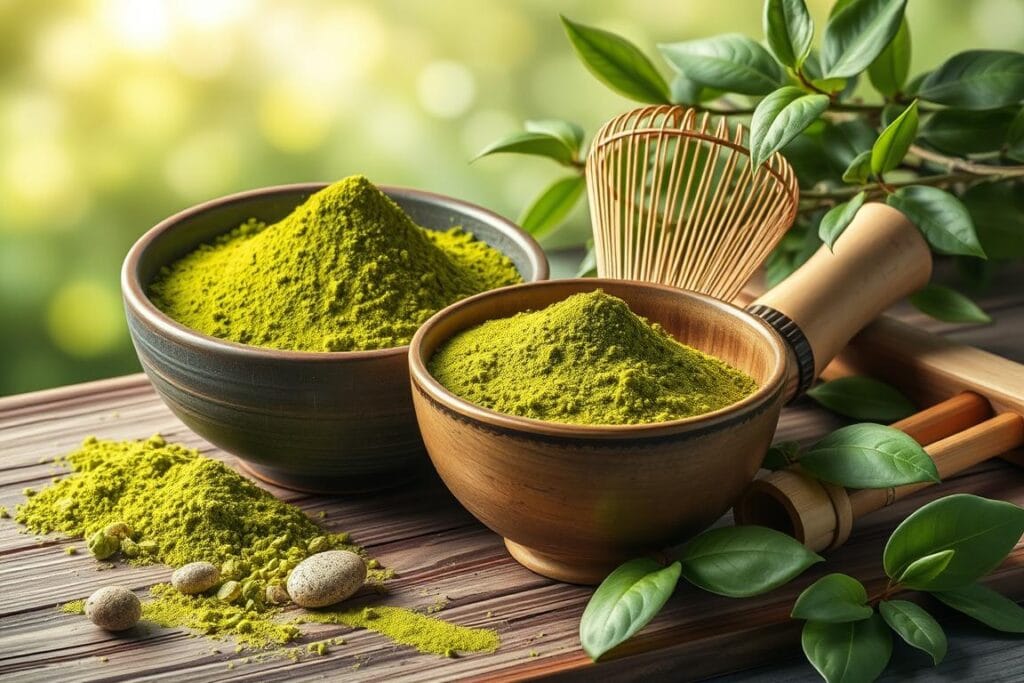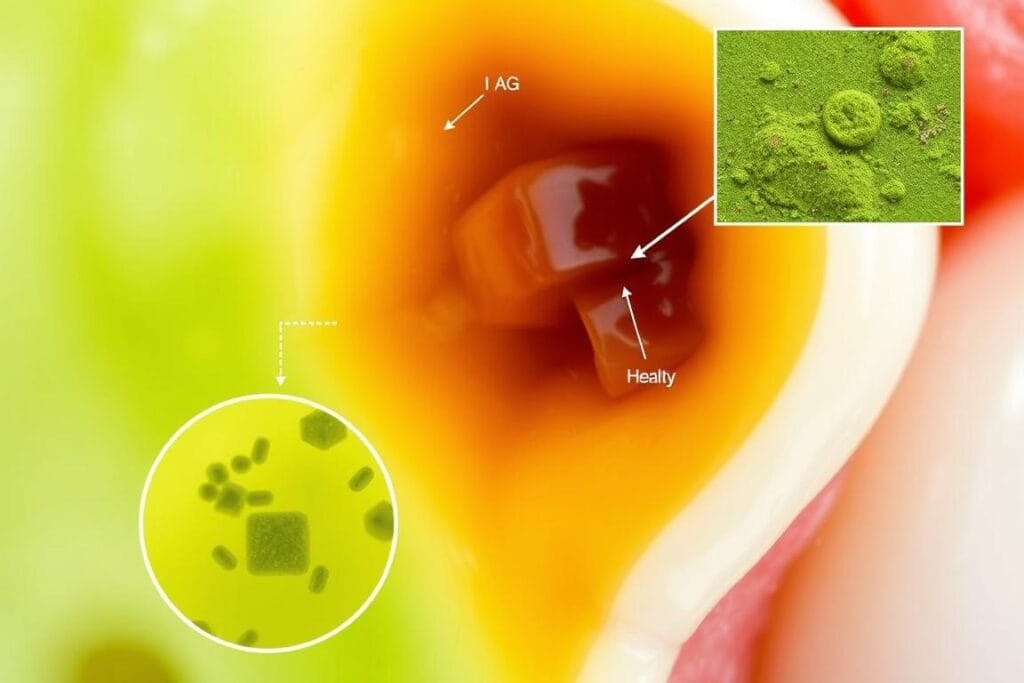
Ever wondered if your favorite green tea sweets harm your teeth? As a matcha lover, I’ve dug deep into how it affects dental health. I found some surprising facts about teeth staining.
Matcha is loved in drinks and desserts, but some fear it stains teeth. The truth is more nuanced. Matcha’s effect on dental health is not just about staining.
Drinking matcha doesn’t have to worry you about your teeth. Knowing how matcha interacts with your enamel lets you enjoy it guilt-free.
Key Takeaways
- Matcha has lower staining compared to other drinks
- Chlorophyll in matcha may help oral health
- Good dental care can prevent staining
- Matcha quality affects its impact on teeth
- How you drink matcha can lower staining risks
Understanding the Composition of Matcha Tea
Explore the world of Japanese sweets and learn about matcha. It’s a superfood treat that’s more than just a drink. Matcha is a finely ground powder from green tea leaves, packed with flavor and nutrition.

Creating matcha is a detailed process. Tea leaves from places like Uji, Kagoshima, and Nishio are chosen. These leaves are known for their quality and unique taste.
Natural Pigments in Matcha
The green color of matcha is not just pretty. It shows the tea’s nutritional strength. High-quality matcha has a deep green color, showing it’s fresh and full of nutrients.
- Vibrant green color suggests high-quality powder
- Fine, silky texture similar to confectioners’ sugar
- Strong aroma reminiscent of freshly cut grass
The Role of Chlorophyll
Chlorophyll is key in matcha. It gives the tea its green color and offers health benefits. It helps fight bad breath and keeps your mouth fresh, making matcha more than a tasty drink.
Tannin Content Analysis
| Matcha Component | Concentration | Health Benefits |
|---|---|---|
| Catechins | High | Antioxidant properties |
| EGCG | Significant | Potential cancer-fighting properties |
| Tannins | Low | Mild astringent effect |
“Matcha is not just a drink, it’s a nutritional powerhouse packed with incredible health benefits.”
Matcha has tannins, but less than other teas. These compounds add to its unique taste and health benefits. The fine powder of matcha makes it a remarkable superfood with many benefits.
The Science Behind Teeth Staining

Teeth staining happens when pigmented foods meet your tooth surface. This process, called chromogenic accumulation, lets color molecules get into dental enamel. Over time, this leads to visible stains.
Several things can cause teeth staining:
- Dietary choices featuring rich pigmented foods
- Personal habits like smoking
- Inconsistent oral hygiene practices
- Aging natural processes
- Specific medication interactions
The tiny pores in dental enamel are key to stain absorption. These pores trap color molecules from foods and drinks. This leads to gradual stains on your teeth.
“Teeth are like sponges – they absorb what they’re exposed to,” says dental researchers.
| Staining Factor | Intensity Level | Long-term Impact |
|---|---|---|
| Coffee/Tea Consumption | High | Significant Discoloration |
| Red Wine | Medium-High | Moderate Staining |
| Smoking | Very High | Severe Discoloration |
Knowing how stains form helps you protect your teeth. It’s about making choices that keep your dental enamel clean and white.
Looking for more context about matcha and dental health? Check out the detailed explanation on Wikipedia’s matcha and teeth staining article.
How Matcha Affects Dental Enamel
Your teeth’s enamel is a key shield against stains. Knowing how matcha affects this area is vital for keeping your enamel healthy.
Porosity and Stain Absorption
Dental enamel is surprisingly porous. This makes it prone to stains from substances like matcha. The tiny channels in your tooth can trap pigments, causing long-term color changes.
- Enamel porosity varies between individuals
- Matcha’s natural pigments can penetrate these tiny channels
- Factors like age and oral hygiene impact stain absorption
Surface Interaction with Matcha Particles
When matcha meets your teeth, its fine particles touch the enamel. Chlorophyll and tannins in matcha can cause tiny stains over time.
“The health of your enamel determines how susceptible your teeth are to discoloration.” – Dental Health Experts
Long-term Effects on Tooth Color
Drinking matcha regularly can change your tooth color over time. Your enamel’s health greatly affects how much discoloration occurs.
| Enamel Condition | Matcha Staining Potentia |
|---|---|
| Healthy, Thick Enamel | Low Staining Risk |
| Weakened or Thin Enamel | Higher Staining Risk |
| Poor Oral Hygiene | Significant Staining Potentia |
Good oral care and careful matcha drinking can reduce tooth staining.
Matcha vs Coffee: A Staining Comparison
Coffee and matcha both affect tooth color, but in different ways. Coffee stains teeth quickly and visibly. Matcha, on the other hand, stains teeth more slowly and less noticeably.
Coffee’s dark colors cause fast and obvious stains. Its strong pigments attach to teeth quickly. Matcha, with its bright green color, stains teeth in a different way.
- Coffee stains penetrate tooth enamel rapidly
- Matcha contains chlorophyll and unique particulate properties
- Individual oral hygiene practices impact staining
Matcha is a gentler coffee alternative. Its fine green tea particles interact with teeth in a unique way. The chlorophyll and tannins in matcha cause less staining than coffee.
| Beverage | Staining Intensity | Dental Impact |
|---|---|---|
| Coffee | High | Rapid enamel discoloration |
| Matcha | Low to Moderate | Gradual, less visible staining |
Your personal oral care routine determines the long-term effects of these beverages on tooth color.
“Understanding the staining effect helps you choose better beverages for your teeth.” – Dental Research Institute
Health Benefits of Matcha for Oral Health
Matcha is more than just a tasty antioxidant snack. It’s a strong ally for your dental health. This vibrant green tea can turn a simple drink into a healthy treat with amazing benefits.
If you’re seeking creative ways to incorporate matcha into your routine, consider this fun take on matcha-infused desserts.
Antibacterial Defense
The green tea catechins in matcha fight off bad oral bacteria. Studies show these compounds can cut down on harmful bacteria in your mouth. This creates a shield for your teeth and gums.
- Reduces risk of gingivitis
- Decreases periodontal disease risk
- Fights bacterial growth well
Cavity Prevention Mechanisms
Matcha’s special mix helps protect against tooth decay. Research shows it can stop bacteria that cause cavities. This makes it a natural friend for your teeth.
“Green tea extract has shown strong activity against bacteria,” which is great for dental care.
Gum Health Enhancement
Drinking matcha regularly can boost your gum health. Studies found people using matcha treatments had less plaque and gum inflammation.
- Reduces plaque buildup
- Minimizes gum inflammation
- Supports overall periodontal wellness
Adding this nutrient-rich tea to your daily routine is more than just enjoying a drink. It’s a smart choice for your long-term dental health.
Debunking Common Myths About Matcha and Teeth
Many myths surround matcha and its effect on teeth. Let’s debunk some of these myths about this vibrant green tea and your teeth.
“Not everything you hear about matcha and teeth staining is true” – Dental Health Experts
Some think matcha will stain their teeth forever. But, this isn’t always true. Green tea has many benefits, not just for looks. Your teeth’s health depends on many things, not just what you drink.
- Myth: Matcha always causes severe tooth discoloration
- Reality: Proper oral hygiene can minimize possible staining
- Fact: Matcha contains compounds that are good for your teeth
The tannin content in matcha is often misunderstood. It might cause a bit of discoloration. But, the tea’s antibacterial properties help your oral health. The trick is to enjoy matcha the right way.
How you drink matcha is key. Rinsing your mouth after drinking it and keeping up with dental care can stop most staining. Your dental health facts should come from science, not just rumors.
Moderation and proper care are the secrets to enjoying matcha without dental worries.
Dentists say matcha should be part of a bigger plan for good oral health. It’s not a danger to your smile alone.
These properties make matcha an excellent addition to a dental-friendly diet, as highlighted in recipes like easy-to-make healthy dishes.
Best Practices for Enjoying Matcha Without Staining
To keep your teeth healthy while drinking matcha, follow some key steps. Learning the right ways to enjoy matcha can prevent tooth stains. This helps you keep your smile shining.
Your dental care is very important to avoid matcha stains. Dentists suggest several ways to enjoy green tea without harming your teeth.
Drinking Techniques for Stain Prevention
- Use a straw when drinking cold matcha beverages to minimize direct contact with teeth
- Rinse your mouth with water immediately after consuming matcha
- Avoid swishing matcha around in your mouth
Smart Consumption Timing
When you drink matcha, timing is key. Wait at least 30 minutes after brushing your teeth. This lets the fluoride protect your teeth and prevents damage.
Proper Cleaning Methods
| Cleaning Strategy | Effectiveness |
|---|---|
| Brushing after matcha | Moderate |
| Water rinse | High |
| Dental floss | Very High |
For the best stain prevention, follow these dental care tips:
- Brush teeth twice daily with whitening toothpaste
- Use dental floss to remove residual particles
- Consider an electric toothbrush for more effective cleaning
“Maintaining excellent oral hygiene is key to enjoying matcha without compromising your dental aesthetics.” – Dental Health Expert
By following these matcha tips, you can enjoy your favorite green tea. And keep your smile bright and healthy.
From Tea to Treats: Making Matcha Brownies
Matcha brownies turn your favorite tea into a tasty dessert. They mix the deep taste of matcha with the softness of brownies. This makes for a dessert that’s both unique and unforgettable.
Matcha brownies are perfect for those who love vegan or gluten-free baking. They offer a fun twist on traditional baking. Here’s a step-by-step guide to making the best batch:
Essential Ingredients
- 2 tablespoons culinary grade matcha powder
- 1 cup granulated sugar
- 1/4 cup light brown sugar
- 3 eggs (room temperature)
- 1 teaspoon vanilla extract
- All-purpose flour (or gluten-free alternative)
- Butter or vegan butter substitute
Baking Process
- Preheat oven to 350°F
- Prepare 8×8 baking pan with butter and parchment paper
- Sift matcha powder to prevent clumping
- Whip sugars, eggs, vanilla for 5-10 minutes until creamy
- Combine dry ingredients carefully
- Bake for 20-25 minutes
Pro tip: Smack the pan gently after baking to eliminate air bubbles and achieve a fudgy texture.
“Matcha brownies are not just a dessert, they’re an experience of flavor and health!” – Culinary Experts
| Nutritional Details | Value |
|---|---|
| Calories per serving | 350 |
| Preparation Time | 15 minutes |
| Baking Time | 25-30 minutes |
| Shelf Life | 5 days at room temperature |
Make your matcha brownies even more special by adding white chocolate chips, M&Ms, or crushed pretzels. High-quality matcha powder is key for a vibrant green color and a rich taste in your gluten-free baking.
Prevention Strategies and Dental Care Tips
To keep your teeth healthy while drinking matcha, you need good oral hygiene. Start by learning how to avoid stains and keep your teeth white.
Using the right dental care can help prevent matcha stains. Your plan should cover all bases and be ready for anything.
- Rinse mouth immediately after drinking matcha
- Use fluoride toothpaste for enhanced enamel protection
- Wait 30 minutes after brushing before consuming matcha
- Consider using a straw for cold matcha beverages
“Consistent oral care is the key to preventing dental stains from any beverage.”
Your daily oral care routine is key to fighting matcha stains. Experts suggest:
- Brush teeth twice daily
- Floss regularly
- Use an antiseptic mouthwash
- Schedule regular dental cleanings
If stains don’t go away, try professional teeth whitening. Choose a treatment that fits your dental needs and talk to your dentist.
| Prevention Strategy | Effectiveness Rating |
|---|---|
| Water rinse after matcha | High |
| Professional cleaning | Very High |
| Whitening treatments | Extremely High |
Remember, proactive dental care is always better than reactive treatment.
Professional Dental Insights on Matcha Consumption
Dental experts share important insights on matcha’s effects on your teeth. They offer advice for those who love tea and want to keep their teeth clean.
Expert Recommendations for Safe Matcha Consumption
Dental pros give tips to avoid matcha stains on your teeth. They suggest:
- Rinse your mouth right after drinking matcha
- Use a straw to reduce tooth contact
- Keep up with good oral hygiene
- Get regular dental check-ups
Treatment Options for Existing Stains
If matcha stains your teeth, dental advice points to professional whitening. Home remedies usually can’t compare to dental treatments.
“Professional treatments can effectively address matcha-related tooth discoloration with targeted approaches,” says a leading dental expert.
Preventive Dental Measures
Understanding matcha’s effect on dental enamel is key. Dentists advise:
- Use soft-bristled toothbrushes
- Choose gentle whitening toothpastes
- Stick to a balanced oral care routine
Following these tips helps you enjoy matcha without harming your teeth or oral health.
The Role of Quality in Matcha’s Effects on Teeth
Not all matcha is the same when it comes to dental health. The quality of matcha greatly affects how it interacts with your teeth. Knowing the difference between high-grade matcha and culinary grade tea can help you choose better for your teeth.
Ceremonial matcha stands out for its high quality. Its unique processing and preparation methods make it different from lower-grade teas. This can affect how it interacts with your teeth.
- High-grade matcha contains more refined particles
- Ceremonial matcha undergoes more careful processing
- Culinary grade tea may have different staining properties
Studies show that matcha quality can change its staining effects. High-grade matcha has a smoother texture that might affect teeth differently than lower-quality teas.
“The purity and processing of matcha can make a significant difference in its dental effects.” – Dental Health Research Institute
| Matcha Grade | Particle Refinement | Potential Teeth Interaction |
|---|---|---|
| Ceremonial Grade | Highest | Minimal Staining |
| Premium Grade | High | Low Staining |
| Culinary Grade | Lower | Higher Staining Risk |
Choose high-grade matcha for better taste and dental health. These premium options might cost more, but they offer great benefits. Always rinse your mouth after drinking matcha to avoid stains.
Conclusion
Exploring matcha opens up a world of tasty and healthy treats. Matcha brownies are a great example of how this green powder can make desserts better. They not only taste good but also offer health benefits.
When you enjoy matcha treats, think about your dental health too. Knowing how to use matcha right can help you enjoy its benefits without harming your teeth. It’s all about eating in moderation and keeping your teeth clean.
Matcha is fun to use in many ways, from tea to desserts like brownies. You can try matcha brownies with green tea or make vegan and gluten-free versions. It’s a way to enjoy different cultures and try new things.
Matcha is more than just a tasty ingredient. It helps with focus, metabolism, and is part of a rich culture. Every time you make matcha, you’re taking care of your health and learning about tradition.
